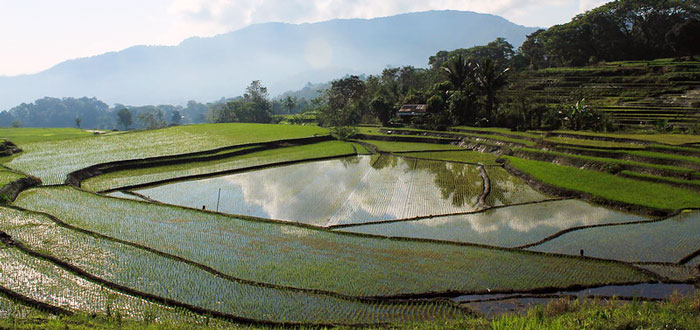Rizières en terrasse d'Ifugao, Philippines
SIPAM depuis 2011

Informations détaillées |
|---|
Localisation: Central Region Cordillera, Philippines du Nord
Surface du SIPAM: 17 138 ha
Population travaillant pour ce système: 161 623 pers.
Caractéristiques topologiques: -
Classification climatique: climat tropical marin
Groupes ethniques / populations autochtones: les communautés Ifugao
Sources de revenus primaires: l'agriculture, la sculpture sur bois et le tissage
Global importance
Over the last century, the Ifugao Rice Terraces had been self-sufficient in food, timber and water. Thanks to an organization of the landscape divided into five components including woodlot and communal forest, swidden farms, rice terraces, settlement areas and water bodies and irrigation systems, this system is an example of adaptation of the local communities to the environment.
However, the rice terraces are now in a very critical stage of deterioration and do not allow the local communities to overcome the poverty line. The continued survival of the terraces is threatened by various factors such as environmental degradation, unregulated development and neglect brought about by urbanization and changing values.
Food and livelihood security
The rice terraces provide multiple goods and services in terms of food security and sovereignty (rice, fishes, shells and vegetable crops are produced), income generation (sale of wood carvings and marketing of tinawon rice, vegetables and other organic products) and quality nutrition (consumption of rice, fishes and shells as protein source).
However, agricultural activities seem not enough to ensure their livelihood security. Indeed, the province of Ifugao is the fourth poorest province in the country having the highest poverty incidence in the Cordillera Administrative Region. Most of the farmers are also engaged in wood carving and weaving to get an income complement.
Biodiversity and ecosystem functions
Due to the different created micro landscapes for this system, Ifugao terraces promote a high and heterogeneous biodiversity. First of all, in the cultivated area, not only the rice, which includes a dozen of varieties, but also root crops, nut palms and fruit trees are cultivated. This system also encourages the wild life around with fishes, insects and amphibians.
Last but not least, this system includes forest inlands gathering more than 264 trees species. The maintenance of biodiversity relies mainly on the capacity of owners to regulate harvest and do continuous sylvicultural operations. It also plays a role of habitat for wild birds and mammals.
Knowledge systems and adapted technologies
The Ifugao Rice Terraces composed by five major components: woodlot (muyung) and communal forest (ala) as source of wood, swidden farms (habal) used for staple crops cultivation, rice terraces (payo), settlement areas (boble) and water bodies and irrigation systems (liting).
Swidden crops ensure the availability of food for families during the lean months or during crop failures in the terraces. It also provides year round supply of animal feeds for native pigs and chickens. Water bodies are used for irrigation, washing and drinking. Normally, water bodies are biodiversity centres that harbour important species of fishes and shells.
Although rice production is done once a year, the terraces are busy the whole year round. After the harvest season, vegetables are grown in organic mounds (pinkol) and flat organic beds (inado) while fish are raised in fish holes (luhok) built inside the terraces.
Cultures, value systems and social organizations
The local management and governance of the rice terraces have been influenced by culture embodied in customary laws based on social taboos and customs handed down from one generation to the other.
The collective nature of Ifugao customary law is the most powerful tool for re-affirming family commitments for the conservation and appropriate treatment of natural resources. Unfortunately, collective decision making is losing its relevance amidst the pressures of modern living leading to commercialization.
Remarkable landscapes, land and water resources management features
Ifugao terraces have shaped a characteristically landscape in the Mountains between 800 and 1500 meters. Indeed, they were previously forested areas while others are presumably grasslands. It is however, the availability of water that dictates the Ifugaos to build terraces.
Moreover, concerning the water management, woodlots are located at the upper fringes overlooking the rice terraces. By virtue of its upper location, it regulates the impact of precipitation by trapping water higher than primary forest and nutrients from rainfall slowly releasing them to the rice terraces below.

